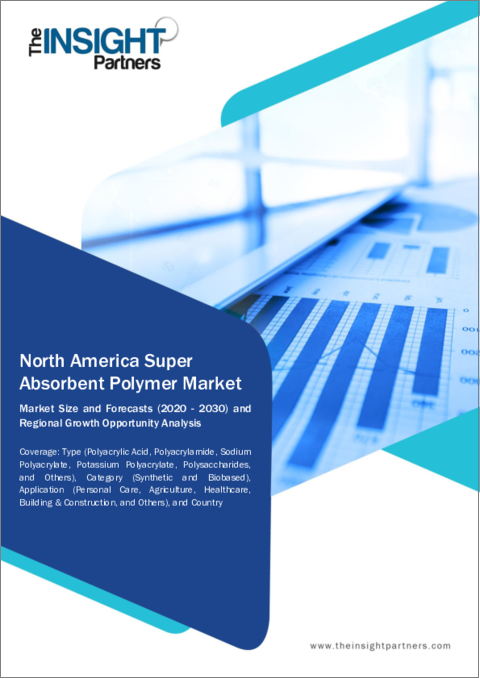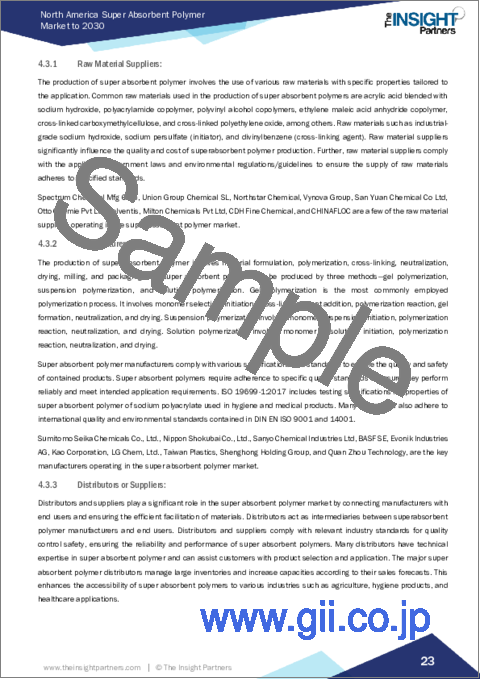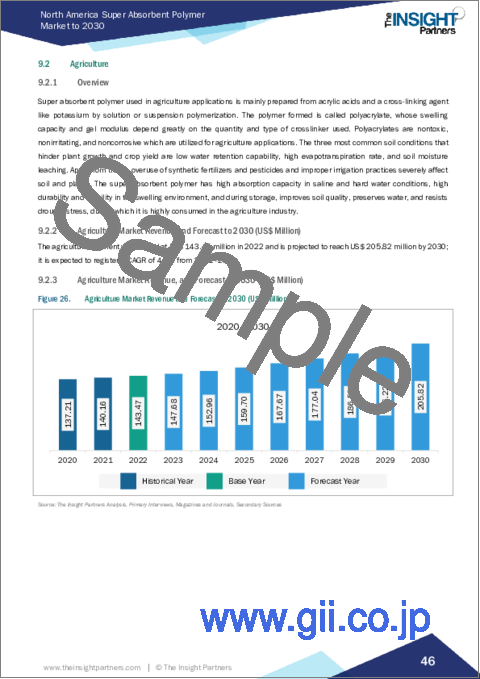|
|
市場調査レポート
商品コード
1567813
アジア太平洋の分子分光法:2030年までの市場予測 - 地域分析 - 製品、技術、用途別Asia Pacific Molecular Spectroscopy Market Forecast to 2030 - Regional Analysis - by Product, Technology, and Application |
||||||
|
|||||||
| アジア太平洋の分子分光法:2030年までの市場予測 - 地域分析 - 製品、技術、用途別 |
|
出版日: 2024年08月07日
発行: The Insight Partners
ページ情報: 英文 125 Pages
納期: 即納可能
|
全表示
- 概要
- 図表
- 目次
アジア太平洋の分子分光法市場は、2022年に8億4,903万米ドルと評価され、2030年には12億8,151万米ドルに達すると予測され、2022年から2030年までのCAGRは5.3%と推定されます。
核磁気共鳴分光法の利用増加でアジア太平洋の分子分光法市場が活性化
NMRは、分子構造を持つ試料の純度を決定するために、品質管理や研究に使用される分析技術です。NMRは、分析化学や連結物質科学、高分子の構造やダイナミクスの解明に威力を発揮します。NMR分光法の利点は、サンプル調製が少なくて済み、研究対象の分子を保存する非破壊的な方法であることです。NMR分光法は、有機化合物の構造を知るための主要な技術のひとつとなっており、医薬品、バイオテクノロジー、バイオ医薬品など、さまざまな分野で広く利用されています。さらに、NMR分光法は、ヒット・ツー・リード検出、代謝物プロファイリング、in vivo磁気共鳴分光法、磁気共鳴イメージングなど、生化学的・生物学的応用においてもますます利用されるようになっています。近年、NMRはメタボロミクスに大きく取り入れられています。この急成長している分野は、代謝物を研究して疾患に関する情報を得るものです。メタボロミクスは、従来は研究用途が中心であったが、実験室での診断に非常に有用であることが証明されました。メタボロミクスは、代謝および細胞プロセスの下流産物に関する貴重な情報を提供し、特定の組織や臓器の状態に関する洞察を得ることができます。NMR分光法は、尿、血漿、血清など様々な体液中の代謝物濃度の定量化に成功しています。NMRスペクトロスコピーは新たな発展を遂げ、必要とされていた感度と汎用性の向上を促し、応用の幅を広げています。先進的なNMR診断技術をヘルスケア産業の最前線に導入することで、様々な疾患の迅速かつ費用対効果の高い診断が可能になると考えられます。研究と産業界のニーズが進化し続ける中、NMR分光法は分析技術の最前線にあり続け、分光法市場の成長を牽引しています。加えて、分子分光法は、環境保全における研究の増加や、環境研究を促進する政府の有利な政策により、大きく推進されています。分子分光法は、調査や環境調査において分析ツールとして使用されることが多いです。そのため市場参入企業は、さまざまな環境調査のために革新的な分子分光法を模索しています。これは予測期間中も継続し、市場に成長機会をもたらすと予想されます。
アジア太平洋の分子分光法市場概要
アジア太平洋の分子分光法市場は、中国、日本、インド、韓国、オーストラリア、その他アジア太平洋地域に区分されます。2022年には中国が市場の最大シェアを占めると予測され、インドは市場で大きな成長率を示すと予測されています。この背景には、中国のバイオ医薬品産業がジェネリック医薬品中心からイノベーションの中心へと大きく変化していることがあります。さらに、工業化の促進や新薬、ハイエンド医療機器、技術の応用が中国市場の成長の要因となっています。さらに、地理的拡大やその他の戦略のためにアジア太平洋諸国に注目する市場企業の増加や、研究センターや政府資金の増加が分子分光法市場の成長に拍車をかけています。
アジア太平洋の分子分光法市場の収益と2030年までの予測(金額)
アジア太平洋の分子分光法市場のセグメンテーション
アジア太平洋の分子分光法市場は、製品、技術、用途、国に区分されます。
製品別では、アジア太平洋の分子分光法市場は装置とアクセサリーに二分されます。2022年の市場シェアは装置セグメントが大きいです。
技術別では、アジア太平洋の分子分光法市場は、紫外可視分光法、赤外分光法、核磁気共鳴分光法、ラマン分光法、近赤外分光法、その他に分類されます。紫外可視分光法セグメントは2022年に最大の市場シェアを占めました。
用途別では、アジア太平洋の分子分光法市場は、学術・研究用途、バイオテクノロジー用途、製薬用途、その他に区分されます。学術・研究用途セグメントが2022年に最大市場シェアを占めました。
国別では、アジア太平洋の分子分光法市場は、オーストラリア、中国、インド、日本、韓国、その他アジア太平洋地域に区分されます。2022年のアジア太平洋の分子分光法市場シェアは中国が独占。
Horiba Ltd、Thermo Fisher Scientific Inc、Merck KGaA、Revvity Inc、Ostec Instruments、JEOL Ltd、Shimadzu Corp、JASCO Corp、Bruker Corp、Agilent Technologies, Inc、Oxfords Instruments plc、Teledyne Princeton Instrumentsは、アジア太平洋の分子分光法市場で事業展開している主要企業です。
目次
第1章 イントロダクション
第2章 エグゼクティブサマリー
- 主要な洞察
第3章 調査手法
- 調査範囲
- 2次調査
- 1次調査
第4章 アジア太平洋の分子分光法市場-主要市場力学
- 市場促進要因
- 分子分光法の普及と利用の拡大
- 製薬業界の急成長
- 市場抑制要因
- 熟練技術者の不足と保守・設置費用の高騰
- 市場機会
- 核磁気共鳴分光法の利用の増加
- 今後の動向
- 創薬と研究開発の増加
- 促進要因と抑制要因の影響
第5章 アジア太平洋の分子分光法市場分析:アジア太平洋分析
- 分子分光法の市場概要
- 分子分光法の市場収益、2020-2030年
第6章 アジア太平洋の分子分光法市場分析:製品別
- 概観
- 装置
- アクセサリ
第7章 アジア太平洋の分子分光法市場分析:技術別
- 紫外可視分光法
- 赤外分光法
- 核磁気共鳴分光法
- ラマン分光法
- 近赤外分光法
- その他
第8章 アジア太平洋の分子分光法市場分析:用途別
- 学術・研究用途
- バイオテクノロジー用途
- 製薬アプリケーション
- その他
第9章 アジア太平洋の分子分光法市場-国別分析
- アジア太平洋の分子分光法市場:国別分析
- アジア太平洋の分子分光法市場:収益と予測分析:国別
- 中国:概要
- 日本:概要
- インド:概要
- オーストラリア:概要
- 韓国:概況
- アジア太平洋のその他:概要
- アジア太平洋の分子分光法市場:収益と予測分析:国別
第10章 分子分光法市場-業界情勢
- 概観
- 分子分光法市場における成長戦略
- 無機的成長戦略
- 有機的成長戦略
第11章 企業プロファイル
- HORIBA, Ltd.
- Thermo Fisher Scientific Inc
- Merck KGaA
- Revvity, Inc.
- Ostec Instruments
- JEOL Ltd.
- Shimadzu Corp
- JASCO Corp
- Bruker Corp
- Agilent Technologies, Inc.
- Oxford Instruments plc
- Teledyne Princeton Instruments
第12章 付録
List Of Tables
- Table 1. Molecular Spectroscopy Market Segmentation
- Table 2. China: Molecular Spectroscopy Market - Revenue and Forecast to 2030 (US$ Million) - by Product
- Table 3. China: Molecular Spectroscopy Market - Revenue and Forecast to 2030 (US$ Million) - by Technology
- Table 4. China: Molecular Spectroscopy Market - Revenue and Forecast to 2030 (US$ Million) - by Application
- Table 5. Japan: Molecular Spectroscopy Market - Revenue and Forecast to 2030 (US$ Million) - by Product
- Table 6. Japan: Molecular Spectroscopy Market - Revenue and Forecast to 2030 (US$ Million) - by Technology
- Table 7. Japan: Molecular Spectroscopy Market - Revenue and Forecast to 2030 (US$ Million) - by Application
- Table 8. India: Molecular Spectroscopy Market - Revenue and Forecast to 2030 (US$ Million) - by Product
- Table 9. India: Molecular Spectroscopy Market - Revenue and Forecast to 2030 (US$ Million) - by Technology
- Table 10. India: Molecular Spectroscopy Market - Revenue and Forecast to 2030 (US$ Million) - by Application
- Table 11. Australia: Molecular Spectroscopy Market - Revenue and Forecast to 2030 (US$ Million) - by Product
- Table 12. Australia: Molecular Spectroscopy Market - Revenue and Forecast to 2030 (US$ Million) - by Technology
- Table 13. Australia: Molecular Spectroscopy Market - Revenue and Forecast to 2030 (US$ Million) - by Application
- Table 14. South Korea: Molecular Spectroscopy Market - Revenue and Forecast to 2030 (US$ Million) - by Product
- Table 15. South Korea: Molecular Spectroscopy Market - Revenue and Forecast to 2030 (US$ Million) - by Technology
- Table 16. South Korea: Molecular Spectroscopy Market - Revenue and Forecast to 2030 (US$ Million) - by Application
- Table 17. Rest of Asia Pacific: Molecular Spectroscopy Market - Revenue and Forecast to 2030 (US$ Million) - by Product
- Table 18. Rest of Asia Pacific: Molecular Spectroscopy Market - Revenue and Forecast to 2030 (US$ Million) - by Technology
- Table 19. Rest of Asia Pacific: Molecular Spectroscopy Market - Revenue and Forecast to 2030 (US$ Million) - by Application
- Table 20. Recent Inorganic Growth Strategies in the Molecular Spectroscopy Market
- Table 21. Recent Organic Growth Strategies in the Molecular Spectroscopy Market
- Table 22. Glossary of Terms, Molecular Spectroscopy Market
List Of Figures
- Figure 1. Molecular Spectroscopy Market Segmentation, by Country
- Figure 2. Molecular Spectroscopy Market - Key Market Dynamics
- Figure 3. Impact Analysis of Drivers and Restraints
- Figure 4. Molecular Spectroscopy Market Revenue (US$ Million), 2020 - 2030
- Figure 5. Molecular Spectroscopy Market Share (%) - by Product (2022 and 2030)
- Figure 6. Instrument: Molecular Spectroscopy Market - Revenue and Forecast to 2030 (US$ Million)
- Figure 7. Accessories: Molecular Spectroscopy Market - Revenue and Forecast to 2030 (US$ Million)
- Figure 8. Molecular Spectroscopy Market Share (%) - by Technology (2022 and 2030)
- Figure 9. UV-Visible Spectroscopy: Molecular Spectroscopy Market - Revenue and Forecast to 2030 (US$ Million)
- Figure 10. Infrared Spectroscopy: Molecular Spectroscopy Market - Revenue and Forecast to 2030 (US$ Million)
- Figure 11. Nuclear Magnetic Resonance Spectroscopy: Molecular Spectroscopy Market - Revenue and Forecast to 2030 (US$ Million)
- Figure 12. Raman Spectroscopy: Molecular Spectroscopy Market - Revenue and Forecast to 2030 (US$ Million)
- Figure 13. Near-Infrared Spectroscopy: Molecular Spectroscopy Market - Revenue and Forecast to 2030 (US$ Million)
- Figure 14. Others: Molecular Spectroscopy Market - Revenue and Forecast to 2030 (US$ Million)
- Figure 15. Molecular Spectroscopy Market Share (%) - by Application (2022 and 2030)
- Figure 16. Academic and Research Applications: Molecular Spectroscopy Market - Revenue and Forecast to 2030 (US$ Million)
- Figure 17. Biotechnology Applications: Molecular Spectroscopy Market - Revenue and Forecast to 2030 (US$ Million)
- Figure 18. Pharmaceutical Applications: Molecular Spectroscopy Market - Revenue and Forecast to 2030 (US$ Million)
- Figure 19. Others: Molecular Spectroscopy Market - Revenue and Forecast to 2030 (US$ Million)
- Figure 20. Asia Pacific: Molecular Spectroscopy Market, by Key Country - Revenue (2022) (US$ Million)
- Figure 21. Asia Pacific: Molecular Spectroscopy Market Breakdown, by Key Countries, 2022 and 2030 (%)
- Figure 22. China: Molecular Spectroscopy Market - Revenue and Forecast to 2030 (US$ Million)
- Figure 23. Japan: Molecular Spectroscopy Market - Revenue and Forecast to 2030 (US$ Million)
- Figure 24. India: Molecular Spectroscopy Market - Revenue and Forecast to 2030 (US$ Million)
- Figure 25. Australia: Molecular Spectroscopy Market - Revenue and Forecast to 2030 (US$ Million)
- Figure 26. South Korea: Molecular Spectroscopy Market - Revenue and Forecast to 2030 (US$ Million)
- Figure 27. Rest of Asia Pacific: Molecular Spectroscopy Market - Revenue and Forecast to 2030 (US$ Million)
- Figure 28. Growth Strategies in the Molecular Spectroscopy Market
The Asia Pacific molecular spectroscopy market was valued at US$ 849.03 million in 2022 and is expected to reach US$ 1,281.51 million by 2030; it is estimated to register a CAGR of 5.3% from 2022 to 2030.
Increasing Use of Nuclear Magnetic Resonance Spectroscopy Boosts Asia Pacific Molecular Spectroscopy Market
NMR is an analytical technique used for quality control and research to determine the purity of a sample with its molecular structure. NMR is a powerful tool in terms of analytical chemistry and consolidated matter science, as well as for elucidating the structure and dynamics of macromolecules. The benefits of NMR spectroscopy are that it requires less sample preparation and is a non-destructive method that preserves the molecules being studied. NMR spectroscopy has become one of the leading techniques for finding out the structure of organic compounds and is widely used in various areas such as pharmaceuticals, biotechnology, and biopharmaceuticals. In addition, NMR spectroscopy is increasingly used in biochemical and biological applications, including hit-to-lead detection, metabolite profiling, in vivo magnetic resonance spectroscopy, and magnetic resonance imaging. In recent years, NMR has been heavily incorporated into metabolomics. This rapidly growing field involves the study of metabolites to gain information about diseases. Metabolomics has traditionally focused on research applications and can prove extremely useful in laboratory diagnostics. Metabolomics can provide valuable information about downstream products of metabolic and cellular processes and provide insights into the state of specific tissues and organs. NMR spectroscopy has successfully quantified metabolite concentrations in various fluids, including urine, plasma, and serum. New developments have been made in NMR spectroscopy, driving much-needed improvements in sensitivity and versatility, and expanding the number of applications. Introducing advanced NMR diagnostic techniques to the frontline healthcare industry will likely enable rapid and cost-effective diagnosis of various diseases. As research and industry needs continue to evolve, NMR spectroscopy remains at the forefront of analytical techniques and drives growth in the spectroscopy market. In addition, molecular spectroscopy has propelled significantly due to increasing research in conservation and favorable government policies to promote environmental studies. Molecular spectroscopy is often used as an analytical tool in surveys and environmental studies. Therefore, market participants are exploring innovative molecular spectroscopy methods for various environmental studies. This is expected to continue during the forecast period and provide growth opportunities for the market.
Asia Pacific Molecular Spectroscopy Market Overview
The Asia Pacific molecular spectroscopy market is segmented into China, Japan, India, South Korea, Australia, and the Rest of Asia Pacific. China is predicted to hold the largest share of the market in 2022, and India is expected to show a significant growth rate in the market. This is due to China's biopharmaceutical industry undergoing a tremendous shift, evolving from a generic-focused to a thriving innovation hub. Additionally, promoting industrialization and the application of novel drugs, high-end medical devices, and techniques are responsible for the market growth in China. Further, the growing number of market players focusing on countries in Asia Pacific for geographical expansion and other strategies and the rising research centers and government funding fuel the molecular spectroscopy market growth.
Asia Pacific Molecular Spectroscopy Market Revenue and Forecast to 2030 (US$ Million)
Asia Pacific Molecular Spectroscopy Market Segmentation
The Asia Pacific molecular spectroscopy market is segmented into product, technology, application, and country.
Based on product, the Asia Pacific molecular spectroscopy market is bifurcated into instrument and accessories. The instrument segment held a larger market share in 2022.
In terms of technology, the Asia Pacific molecular spectroscopy market is categorized into UV-Visible spectroscopy, infrared spectroscopy, nuclear magnetic resonance spectroscopy, Raman spectroscopy, Near-infrared spectroscopy, and others. The UV-Visible spectroscopy segment held the largest market share in 2022.
By application, the Asia Pacific molecular spectroscopy market is segmented into academic and research applications, biotechnology applications, pharmaceutical applications, and others. The academic and research applications segment held the largest market share in 2022.
Based on country, the Asia Pacific molecular spectroscopy market is segmented into Australia, China, India, Japan, South Korea, and the Rest of Asia Pacific. China dominated the Asia Pacific molecular spectroscopy market share in 2022.
Horiba Ltd; Thermo Fisher Scientific Inc; Merck KGaA; Revvity Inc; Ostec Instruments; JEOL Ltd; Shimadzu Corp; JASCO Corp; Bruker Corp; Agilent Technologies, Inc.; Oxfords Instruments plc; and Teledyne Princeton Instruments are some of the leading companies operating in the Asia Pacific molecular spectroscopy market.
Table Of Contents
1. Introduction
- 1.1 The Insight Partners Research Report Guidance
- 1.2 Market Segmentation
2. Executive Summary
- 2.1 Key Insights
3. Research Methodology
- 3.1 Coverage
- 3.2 Secondary Research
- 3.3 Primary Research
4. Asia Pacific Molecular Spectroscopy Market-Key Market Dynamics
- 4.1 Market Drivers
- 4.1.1 Growing Adoption and Use of Molecular Spectroscopy
- 4.1.2 Rapid Growth of Pharmaceutical Industry
- 4.2 Market Restraints
- 4.2.1 Shortage of Technically Skilled Personnel and High Cost of Maintenance and Installation
- 4.3 Market Opportunities
- 4.3.1 Increasing Use of Nuclear Magnetic Resonance Spectroscopy
- 4.4 Future Trends
- 4.4.1 Increase in Drug Discovery and R&D
- 4.5 Impact of Drivers and Restraints:
5. Molecular Spectroscopy Market - Asia Pacific Analysis
- 5.1 Molecular Spectroscopy Market Overview
- 5.2 Molecular Spectroscopy Market Revenue (US$ Million), 2020-2030
6. Asia Pacific Molecular Spectroscopy Market Analysis-by Product
- 6.1 Overview
- 6.2 Instrument
- 6.2.1 Overview
- 6.2.2 Instrument: Molecular Spectroscopy Market - Revenue and Forecast to 2030 (US$ Million)
- 6.3 Accessories
- 6.3.1 Overview
- 6.3.2 Accessories: Molecular Spectroscopy Market - Revenue and Forecast to 2030 (US$ Million)
7. Asia Pacific Molecular Spectroscopy Market Analysis-by Technology
- 7.1 Overview
- 7.2 UV-Visible Spectroscopy
- 7.2.1 Overview
- 7.2.2 UV-Visible Spectroscopy: Molecular Spectroscopy Market - Revenue and Forecast to 2030 (US$ Million)
- 7.3 Infrared Spectroscopy
- 7.3.1 Overview
- 7.3.2 Infrared Spectroscopy: Molecular Spectroscopy Market - Revenue and Forecast to 2030 (US$ Million)
- 7.4 Nuclear Magnetic Resonance Spectroscopy
- 7.4.1 Overview
- 7.4.2 Nuclear Magnetic Resonance Spectroscopy: Molecular Spectroscopy Market - Revenue and Forecast to 2030 (US$ Million)
- 7.5 Raman Spectroscopy
- 7.5.1 Overview
- 7.5.2 Raman Spectroscopy: Molecular Spectroscopy Market - Revenue and Forecast to 2030 (US$ Million)
- 7.6 Near-Infrared Spectroscopy
- 7.6.1 Overview
- 7.6.2 Near-Infrared Spectroscopy: Molecular Spectroscopy Market - Revenue and Forecast to 2030 (US$ Million)
- 7.7 Others
- 7.7.1 Overview
- 7.7.2 Others: Molecular Spectroscopy Market - Revenue and Forecast to 2030 (US$ Million)
8. Asia Pacific Molecular Spectroscopy Market Analysis-by Application
- 8.1 Overview
- 8.2 Academic and Research Applications
- 8.2.1 Overview
- 8.2.2 Academic and Research Applications: Molecular Spectroscopy Market - Revenue and Forecast to 2030 (US$ Million)
- 8.3 Biotechnology Applications
- 8.3.1 Overview
- 8.3.2 Biotechnology Applications: Molecular Spectroscopy Market - Revenue and Forecast to 2030 (US$ Million)
- 8.4 Pharmaceutical Applications
- 8.4.1 Overview
- 8.4.2 Pharmaceutical Applications: Molecular Spectroscopy Market - Revenue and Forecast to 2030 (US$ Million)
- 8.5 Others
- 8.5.1 Overview
- 8.5.2 Others: Molecular Spectroscopy Market - Revenue and Forecast to 2030 (US$ Million)
9. Asia Pacific Molecular Spectroscopy Market-Country Analysis
- 9.1 Asia Pacific Molecular Spectroscopy Market-Country Analysis
- 9.1.1 Asia Pacific: Molecular Spectroscopy Market - Revenue and Forecast Analysis - by Country
- 9.1.1.1 China: Overview
- 9.1.1.1.1 China: Molecular Spectroscopy Market - Revenue and Forecast to 2030 (US$ Million)
- 9.1.1.1.2 China: Molecular Spectroscopy Market Breakdown, by Product
- 9.1.1.1.3 China: Molecular Spectroscopy Market Breakdown, by Technology
- 9.1.1.1.4 China: Molecular Spectroscopy Market Breakdown, by Application
- 9.1.1.2 Japan: Overview
- 9.1.1.2.1 Japan: Molecular Spectroscopy Market - Revenue and Forecast to 2030 (US$ Million)
- 9.1.1.2.2 Japan: Molecular Spectroscopy Market Breakdown, by Product
- 9.1.1.2.3 Japan: Molecular Spectroscopy Market Breakdown, by Technology
- 9.1.1.2.4 Japan: Molecular Spectroscopy Market Breakdown, by Application
- 9.1.1.3 India: Overview
- 9.1.1.3.1 India: Molecular Spectroscopy Market - Revenue and Forecast to 2030 (US$ Million)
- 9.1.1.3.2 India: Molecular Spectroscopy Market Breakdown, by Product
- 9.1.1.3.3 India: Molecular Spectroscopy Market Breakdown, by Technology
- 9.1.1.3.4 India: Molecular Spectroscopy Market Breakdown, by Application
- 9.1.1.4 Australia: Overview
- 9.1.1.4.1 Australia: Molecular Spectroscopy Market - Revenue and Forecast to 2030 (US$ Million)
- 9.1.1.4.2 Australia: Molecular Spectroscopy Market Breakdown, by Product
- 9.1.1.4.3 Australia: Molecular Spectroscopy Market Breakdown, by Technology
- 9.1.1.4.4 Australia: Molecular Spectroscopy Market Breakdown, by Application
- 9.1.1.5 South Korea: Overview
- 9.1.1.5.1 South Korea: Molecular Spectroscopy Market - Revenue and Forecast to 2030 (US$ Million)
- 9.1.1.5.2 South Korea: Molecular Spectroscopy Market Breakdown, by Product
- 9.1.1.5.3 South Korea: Molecular Spectroscopy Market Breakdown, by Technology
- 9.1.1.5.4 South Korea: Molecular Spectroscopy Market Breakdown, by Application
- 9.1.1.6 Rest of Asia Pacific
- 9.1.1.6.1 Overview
- 9.1.1.6.2 Rest of Asia Pacific: Molecular Spectroscopy Market - Revenue and Forecast to 2030 (US$ Million)
- 9.1.1.6.3 Rest of Asia Pacific: Molecular Spectroscopy Market Breakdown, by Product
- 9.1.1.6.4 Rest of Asia Pacific: Molecular Spectroscopy Market Breakdown, by Technology
- 9.1.1.6.5 Rest of Asia Pacific: Molecular Spectroscopy Market Breakdown, by Application
- 9.1.1.1 China: Overview
- 9.1.1 Asia Pacific: Molecular Spectroscopy Market - Revenue and Forecast Analysis - by Country
10. Molecular Spectroscopy Market-Industry Landscape
- 10.1 Overview
- 10.2 Growth Strategies in the Molecular Spectroscopy Market
- 10.3 Inorganic Growth Strategies
- 10.3.1 Overview
- 10.4 Organic Growth Strategies
- 10.4.1 Overview
11. Company Profiles
- 11.1 HORIBA, Ltd.
- 11.1.1 Key Facts
- 11.1.2 Business Description
- 11.1.3 Products and Services
- 11.1.4 Financial Overview
- 11.1.5 SWOT Analysis
- 11.1.6 Key Developments
- 11.2 Thermo Fisher Scientific Inc
- 11.2.1 Key Facts
- 11.2.2 Business Description
- 11.2.3 Products and Services
- 11.2.4 Financial Overview
- 11.2.5 SWOT Analysis
- 11.2.6 Key Developments
- 11.3 Merck KGaA
- 11.3.1 Key Facts
- 11.3.2 Business Description
- 11.3.3 Products and Services
- 11.3.4 Financial Overview
- 11.3.5 SWOT Analysis
- 11.3.6 Key Developments
- 11.4 Revvity, Inc.
- 11.4.1 Key Facts
- 11.4.2 Business Description
- 11.4.3 Products and Services
- 11.4.4 Financial Overview
- 11.4.5 SWOT Analysis
- 11.4.6 Key Developments
- 11.5 Ostec Instruments
- 11.5.1 Key Facts
- 11.5.2 Business Description
- 11.5.3 Products and Services
- 11.5.4 Financial Overview
- 11.5.5 SWOT Analysis
- 11.5.6 Key Developments
- 11.6 JEOL Ltd.
- 11.6.1 Key Facts
- 11.6.2 Business Description
- 11.6.3 Products and Services
- 11.6.4 Financial Overview
- 11.6.5 SWOT Analysis
- 11.6.6 Key Developments
- 11.7 Shimadzu Corp
- 11.7.1 Key Facts
- 11.7.2 Business Description
- 11.7.3 Products and Services
- 11.7.4 Financial Overview
- 11.7.5 SWOT Analysis
- 11.7.6 Key Developments
- 11.8 JASCO Corp
- 11.8.1 Key Facts
- 11.8.2 Business Description
- 11.8.3 Products and Services
- 11.8.4 Financial Overview
- 11.8.5 SWOT Analysis
- 11.8.6 Key Developments
- 11.9 Bruker Corp
- 11.9.1 Key Facts
- 11.9.2 Business Description
- 11.9.3 Products and Services
- 11.9.4 Financial Overview
- 11.9.5 SWOT Analysis
- 11.9.6 Key Developments
- 11.10 Agilent Technologies, Inc.
- 11.10.1 Key Facts
- 11.10.2 Business Description
- 11.10.3 Products and Services
- 11.10.4 Financial Overview
- 11.10.5 SWOT Analysis
- 11.10.6 Key Developments
- 11.11 Oxford Instruments plc
- 11.11.1 Key Facts
- 11.11.2 Business Description
- 11.11.3 Products and Services
- 11.11.4 Financial Overview
- 11.11.5 SWOT Analysis
- 11.11.6 Key Developments
- 11.12 Teledyne Princeton Instruments
- 11.12.1 Key Facts
- 11.12.2 Business Description
- 11.12.3 Products and Services
- 11.12.4 Financial Overview
- 11.12.5 SWOT Analysis
- 11.12.6 Key Developments
12. Appendix
- 12.1 About The Insight Partners
- 12.2 Glossary of Terms






